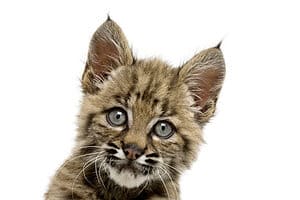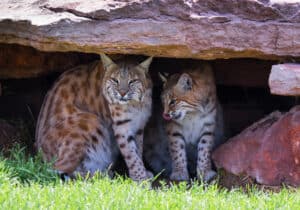Bobcats can be found almost everywhere in North America. They are phantom-like medium-sized cats that quietly stalk their prey and prefer to stay hidden from humans. While it’s more common to spot these adorable felines in your local state park or wooded area, they sometimes sneak into neighborhoods and backyards.
In this article, we are going to dive into where bobcats live in Arkansas and other fun facts about this cute wild cat.
Are There Bobcats in Arkansas?

Bobcats can be found in Arkansas.
©Victor Arita/Shutterstock.com
There are many bobcats in Arkansas, but there isn’t an accurate estimate. However, their populations are stable enough that there is a hunting season. Bobcats hide very well. Even if you’ve lived in Arkansas your whole life, there is no telling if you’ll ever encounter one. They are fast runners and jump high to escape from predators and pounce on prey. Their spotted coats help them blend into their environment.
When Can You Hunt Bobcats in Arkansas?
You can’t hunt for bobcats all year round in Arkansas. The Arkansas Game and Fish Commission categorizes bobcats as furbearers. Their coats are sold after they are skinned and cleaned. The official hunting season for this upcoming year is Sept. 1, 2022-Feb. 28, 2023. The limit is two bobcats per day and not all weapons are permitted. You also need to be over 16 years old and have a valid hunting license to participate. If you want your hound to participate, you are in luck. You can hunt with dogs during the day, but at night it’s required. Bobcats know how to run and can have your dog chasing them in circles for hours.
Where Do Bobcats Live in Arkansas?
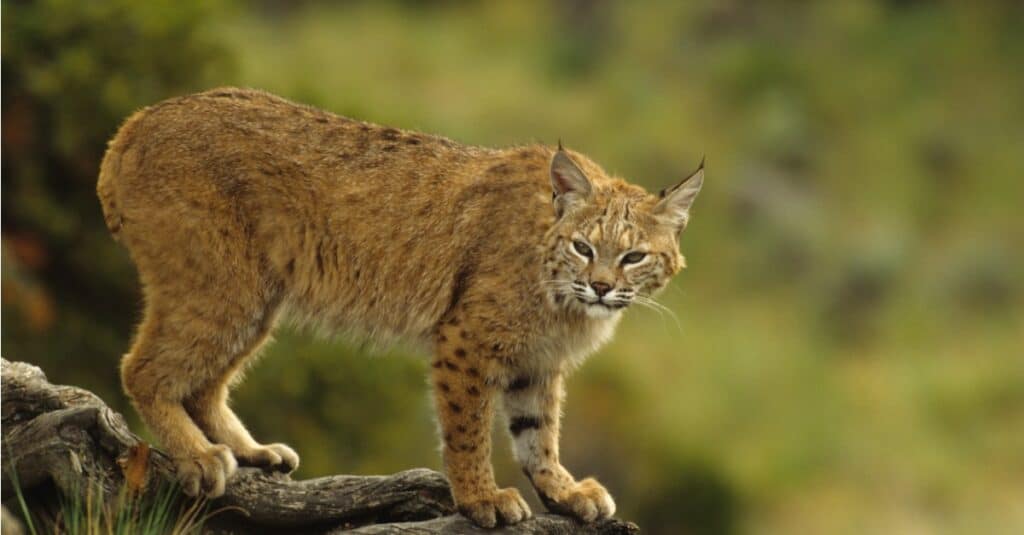
Bobcats can adapt to many different environments.
©iStock.com/twildlife
It’s safe to say that bobcats are not afraid to travel. They live just about anywhere in Arkansas and adapt to many different environments. That being said, they thrive in woodlands but have been found in mountainous regions and swamps. You might have the best chance of spotting a bobcat in Little Rock. The population is stable enough that some people have started seeing them roaming during the day in their neighborhoods. Many towns in Arkansas were built in between or on the edge of forests.
Bobcats live anywhere they can find a healthy population of food. This includes suburban neighborhoods as they hunt for small rodents like rabbits and rats. Bobcats also climb up trees, so watch your head! While the population is stable, these quiet predators rarely make their presence known. If you want to look for them, visit the Ozark National Forest and take a hiking trail.
How Big Is a Bobcat in Arkansas?
Generally, bobcats grow up to 37 inches long and weigh 35 pounds. They are about twice the size of a small domestic cat. Female bobcats are typically smaller and weigh less. However, there are always exceptions. For example, the largest bobcat ever caught in the world weighed 52 pounds in Wisconsin on December 31, 2008. Some hunters though have stated they’ve seen and caught bobcats up to 75 pounds, but this is unofficial.
What Other Wild Cats Are in Arkansas?
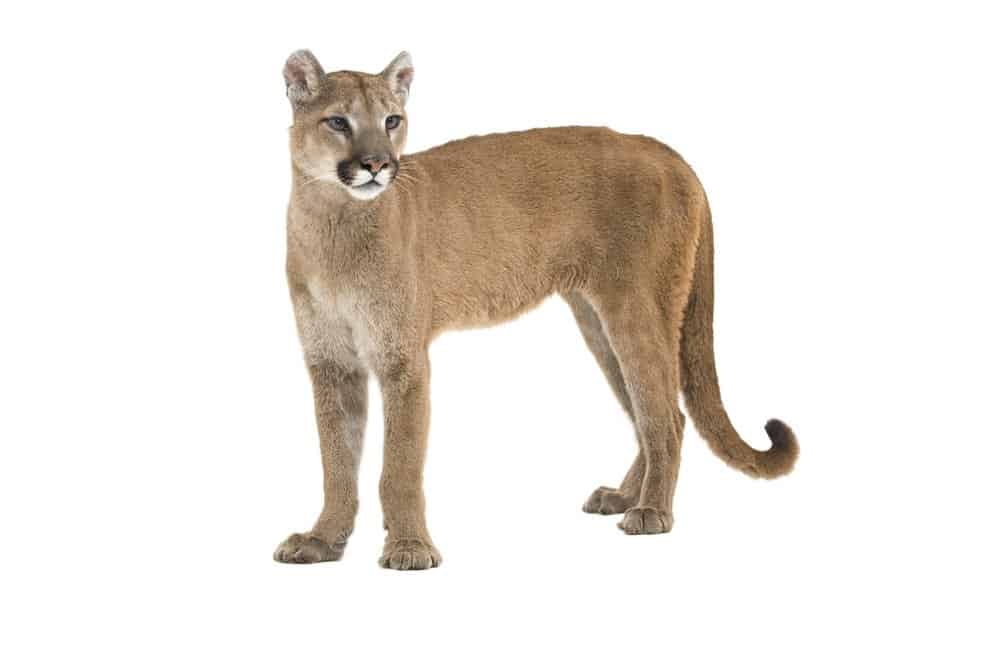
Mountain lions have been scarcely sighted in Arkansas.
©Ultrashock/Shutterstock.com
Would it surprise you to know that other large wild cats like in Arkansas? The other two wild cats living in Arkansas are mountain lions and Florida panthers. However, their populations aren’t stable. Florida panthers typically live in Florida, but they’ve been spotted as far as Arkansas. Before the 1920s, their population was higher, but now they are a rare sight. State wildlife officials have not confirmed their existence in the state, since they aren’t sure if the Florida panther is breeding or just roaming through. Florida panthers are endangered and experts believe less than 300 wild panthers exist in North America today.
What about mountain lions? Until recently, there were scarce sightings in Arkansas. However, now that the deer population is abundant, it’s not surprising to see these large and long-tailed cats returning. Many Arkansas residents have claimed to see them in the mountains and forest, but these are unofficial reports. However, officials did confirm a mountain lion sighting near Mammoth Spring in Northern Arkansas.
What Do You Do if You See a Bobcat in Your Neighborhood?
While it’s unlikely a bobcat will venture into your home or neighborhood since it’s crowded or loud, you should know what to do just in case. First, take a step back and breathe. Something to know is that although bobcats are fierce hunters, they are more afraid of us than we are of them. Usually, bobcats run away if they sense you, but if they don’t, slowly move back and make noise or spray them with water. Don’t run though, as this can trigger their hunting instincts, leading to a chase.
Bonus: Do Bobcats Prey on Pets?
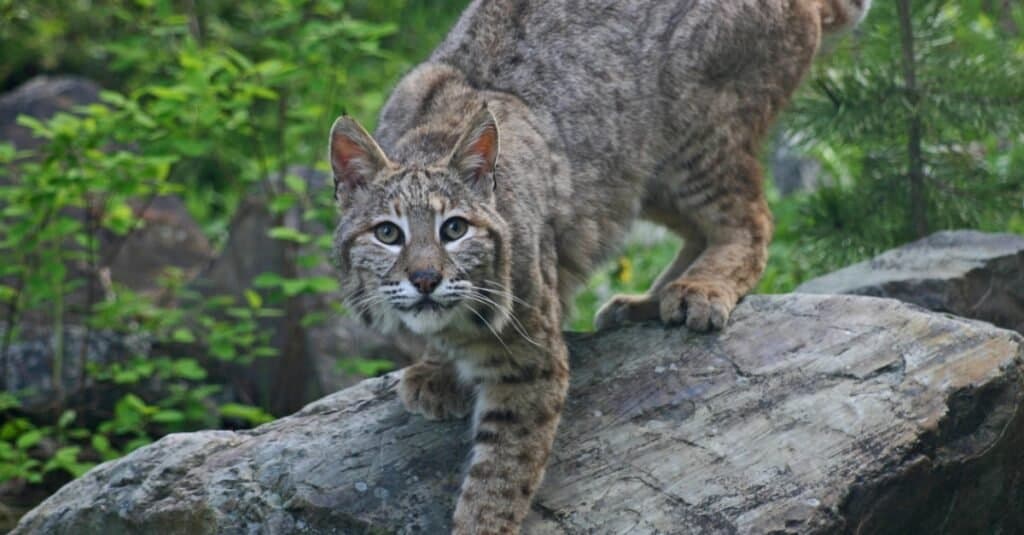
Bobcats will eat anything they can bring down – including small pets.
©iStock.com/Anita Elder Design
Bobcats may not be very dangerous to humans – but you may forget that these fierce felines will prey on smaller pets if given the chance! While attacks on pets aren’t common they are increasing in frequency as humans continue to encroach on their native habitats. Bobcats are highly adaptive – which is a major reason for their success as a species. If people move into their territory – they will adapt – perhaps finding small dogs and domestic cats to be easy new prey.
Small dogs left in fenced backyards are easy game for these agile predators. They can jump or climb a fence with minimal effort and are powerful animals. Pet cats that roam outside would also be easy targets for experienced hunters. Farm animals like goats and chickens are also at risk. If you suspect a bobcat is in your neighborhood, keep your cats inside and don’t leave small dogs outside alone. Goats and chickens can be protected by trained guard dogs.
The photo featured at the top of this post is © Karyn Honor/Shutterstock.com
Thank you for reading! Have some feedback for us? Contact the AZ Animals editorial team.



